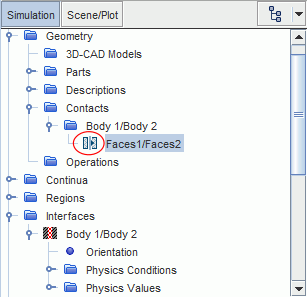Specifying the Orientation of Non-Conformal Interfaces
In multi-part assemblies, Simcenter STAR-CCM+ automatically handles non-conformal solid-solid interfaces based on a primary-secondary algorithm. In some applications, the presence of multiple interacting non-conformal interfaces may lead to over-constraining of the solid parts. In these cases, Simcenter STAR-CCM+ allows you to manually set the interface orientation to specify the primary and secondary boundaries.
In the primary-secondary algorithm for
non-conformal mesh, the secondary side of the interface corresponds to the boundary
which is more flexible, that is, the boundary with a finer mesh. Simcenter STAR-CCM+ automatically specifies the secondary
boundary based on the average dimension of the mesh element faces at each side of
the interface. If the automatic specification results in over-constraining of the
parts, Simcenter STAR-CCM+ issues a warning message similar
to the following:
NOTE: multiple constraints from groups of interacting solid solid interfaces:{17,18}
NOTE: if the result is incorrect or the matrix singular, it might be due to over/redundant constraint from interacting solid solid interfaces.
You may use Manual Orientation to select the secondaries manually. In Manual Orientation, each secondary vertex is constrained only once.
When Simcenter STAR-CCM+ issues this warning, specify the orientation of interacting interfaces manually. For all other interfaces, leave the automatic orientation.
For interfaces that interact which other:
-
Select the relevant
node and set
Mode to
Manual.
The Orientation node is only available for interfaces between parts that are assigned to the same region.
When using manual orientation,
Simcenter STAR-CCM+ specifies the interface boundary
Part 1/Part 2 [0] as the secondary boundary. You can
change the orientation of the contacts to specify the other side of the interface as
boundary [0]:
-
Right-click the
Orientation node and select
Reverse Contacts...
You can check the interface orientation by examining the icon next to the associated contact.
